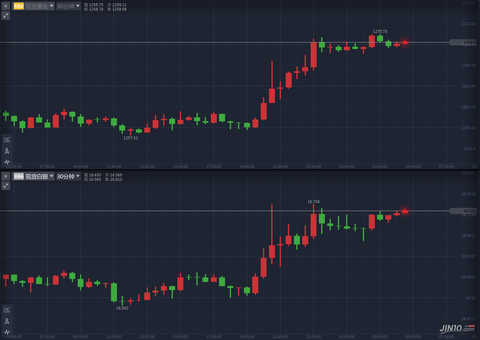Last week, gold, silver and crude oil bulls experienced a “carnival weekâ€, with gold and silver rising more than 1%, and crude oil hitting the biggest single-week gain in the year. Affected by this, the speculative net long positions of the two major markets both rose. Next, investors need to be wary of the two central bank decisions and a series of US data to disrupt the market.
· Gold rose 1.1% last week, rising for three consecutive weeks;
· North Korea once again tested the intercontinental ballistic missiles and detonated the gold bulls;
· Market optimism continues, and gold speculative shorts are reduced on a large scale;
· The crude oil bulls ushered in the “Carnival Weekâ€, and the US and the two oils created the biggest weekly gain in the year;
· The number of active oil drilling in the United States has increased by two, but only 10 in July;
· The net long position of speculative crude oil increased by 26,879 lots, rising for the fourth consecutive week.
Precious metal
Last Friday (July 28), the United States announced a series of mixed data, allowing NYMEX August delivery of gold futures prices rose 8.40 US dollars or 0.7%, to 1268.40 US dollars / ounce, last week, a cumulative increase of 1.1%, for the third consecutive Weekly higher; silver futures for September delivery rose 12.2 cents, or 0.7%, to $16.698, a cumulative increase of 1.5% in the overall trading last week.

Precious metals continued to rise last week, mainly benefiting from the performance of the US Congress and the Federal Reserve. At the beginning of the week, the political turmoil in the White House gradually faded, causing the price of gold to fall. However, the House of Representatives passed a bill to sanction Russia on Tuesday, which made the relationship between the two sides tense again. On the same day, the Trump Medical Reform Act failed in the Senate vote. He had previously said that he would pass the medical reform and then carry out the tax reform. This failure made his next policy deployment seem even more distant, and whether the market can promote its stimulus policy. The expectations are biased towards negative and provide support for the price of gold.
The Fed’s debut on Thursday boosted the gold’s gains. In the announcement of the Federal Reserve’s July meeting in the early hours of Thursday, some key wordings have changed, especially on the issue of inflation, acknowledging that inflation is a long-term phenomenon rather than the “short-term factor†previously mentioned. This statement was regarded by the market as a "doves" signal, causing gold to immediately break the $1,260 mark.
The next day's second quarter real GDP annual rate was recorded at 2.6%, which was in line with expectations and far higher than the previous value, but it turned out that this was not enough to offset the impact of the Fed's "pigeon" sound. After a small decline, it continued to rise. Shortly afterwards, North Korea’s test-fired missiles culminated in last week’s rally. On the evening of the same day, the second test of North Korea could fly with the ballistic missiles of the United States, which detonated the final carnival of the bulls. The price of gold once soared above $1,270.
A large number of strong bullish factors have brought about high optimism. Kitco's weekly gold survey shows that Wall Street professionals and regular investors agree that the gold rally will continue next week. According to the latest position report of the US Commodity Futures Trading Commission (CFTC), as of the week of July 25, the speculative short positions of gold began to flee, and the short position of gold was greatly reduced by 27,626 contracts. The last time such a large-scale short position was reduced It dates back to 2000. Affected by this, gold speculative net long position increased for the first time in 7 weeks, an increase of 30,693 hands to 90,831 hands.

Among other metal contracts traded in NYMEX, copper futures for September delivery fell less than half a cent to close at $2.875/lb, but rose sharply by about 5.6% last week; platinum futures prices for October delivery rose 10.20 US dollars or 1.1% to 936.60 US dollars / ounce, but still fell about 0.1% last week; palladium futures prices for September delivery rose 3.25 US dollars or 0.4% to 880.15 US dollars / ounce, a cumulative increase of 4.2% last week.
Energy class
Last week, the oil market ushered in a number of heavyweights, and the crude oil bulls also experienced their "carnival week." On Friday, NYMEX's WTI crude oil futures for September delivery rose 0.67 US dollars or 1.4% to 49.71 US dollars / barrel, the cumulative increase in the week reached 8.6%; ICE September delivery of Brent crude oil futures prices also rose 1.03 US dollars or 2 %, to $52.52/barrel, last week's cumulative increase of 9.3%. Both oils have hit the largest weekly percentage increase since the week of December 2 last year.

Last week, the good news in the oil market almost occupied the daily headlines. OPEC and non-OPEC oil-producing countries held a meeting in St. Petersburg on Monday. In addition to expressing confidence in the future of oil prices, the countries also proposed practical solutions: First, Saudi Arabia will significantly reduce production and exports in August; In the future, the implementation rate will be reduced to 100%; third, it may be discussed to extend production to March next year.
In addition, the debt crisis of the US shale oil industry, which had been rumored to have appeared, seems to have exploded. Anadarko’s earnings report released on Monday showed that the company plans to cut its capital expenditures by $300 million in 2017, and ConocoPhillips (COPN) announced on Thursday that it will cut its capital expenditure by 4% in 2017. Strategies adopted by other major US shale oil producers. If this plan is implemented, the future exploration and mining activities of shale oil will be greatly affected.
By throwing away the expected boost, the data also provides solid support for the rise in oil prices. API crude oil inventories fell sharply by 10.2 million barrels on Wednesday morning, the largest decline since September 2016; the EIA's four major inventories fell in the evening, and crude oil inventories fell by more than 7.208 million barrels, far exceeding expectations, and this is also US crude oil. Inventory fell for the fourth consecutive week, and it seems that OPEC's long-term unsuccessful production cuts have finally yielded results. In addition, US crude oil production has also begun to decline, I do not know whether the shale oil industry debt crisis began. As of the week of July 28, the number of active oil drilling in the United States increased by two to 766, but only 10 in July.
It is worth noting that the Venezuelan government held the constitutional assembly election on July 30. Trump had threatened that if the Maduro regime insisted on holding the constitutional assembly election, the US will quickly adopt strict economic measures. The previous article of Jin 10 analyzed in detail the impact of the US conflict on oil prices, the biggest possibility. It is to push the oil price up, and the upward range depends on the duration of the unrest.
The CFTC's position report showed that the speculative net long position in the crude oil futures market increased by 26,879 lots to 423,338 lots, which is already the fourth consecutive week of crude oil net long positions, and the oil market optimism continues.

In other energy trading in NYMEX, gasoline futures for August delivery rose 3.2 cents, or 1.9%, to 1.676 US dollars per gallon, up 7.2% last week; natural gas futures for September delivery closed down 2.6 cents or 0.9% to $2.941 per million British thermal units, a cumulative decline of 0.7% in last week's trading
[This week's prospects]
In terms of data, the Reserve Bank of Australia's interest rate decision on Tuesday and the US PCE price index for June will be released on Tuesday. The US ADP employment in July and the EIA crude oil inventory data for the week ending July 28 will be released on Wednesday; the US will be released on Thursday to July 29 At the beginning of the week, the number of people claiming unemployment benefits was also announced by the Bank of England. On Friday, there was a heavy US unemployment rate in July and a seasonally adjusted non-agricultural employment. Investors should pay close attention.
No. nickname: follow and trust in order to thank its fans for a long time, Zhao old shareholders recently carried out free bonus shares and consultation activities.
Please pay attention to the old Zhao Micro Signal: njj583
You are not allowed to put just the right hands, grasp impervious stocks sent me, so old Zhao is your pulse. At the same time, you can also get a set of trading course "Golden Warfare", and there are three bull stocks recommended in the market every day!
Equestrian Base Layer long-sleeved women's equestrian base layer tops made of 80% Nylon + 20% Spandex, with high resilience and abrasion resistance. Comfortable four-way stretch, anti-UV, moisture wicking and quick drying.
Women Jodhpurs horse riding tops long-sleeved models, moisture-wicking, breathable and sexy.
Outdoor sports are more sunny, Horse Riding Women equestrian long-sleeved shirts wear can increase the physical sun protection area, but also suitable for winter riding as a base shirt.

Equestrian Base Layer,Equestrian Short Sleeve Tops,Equestrian Base Layer Top,Dry Equetrian Shirts Tops
Guangzhou Muxin Sporting Goods.Ltd. , https://www.muxinsports.com